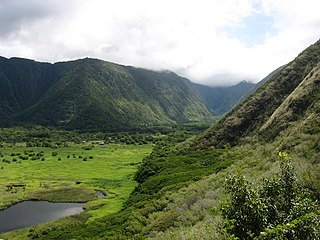Reign

According to the legends, Kalapana was a successor of the cruel Chief Kamaiole. [3]
Kalapana was a High Chief who lived in ancient Hawaii. [1]
Kalapana is also known as Kalapanakuʻioʻiomoa and Kalapaua. Kalapanakuʻioʻiomoa is his longest name that includes the nickname. He is commonly known as either Kalapa or Kalapana.
Kalapana was possibly a son of Prince Kanaloa and his sister Makoʻani, who are the children of Hualani of Molokai and Chief Kanipahu. [2] Kalapana married Malamaʻihanaʻae and their son was Chief Kahaimoelea.

According to the legends, Kalapana was a successor of the cruel Chief Kamaiole. [3]

Kalapana is a town and a region in the Puna District on the Island of Hawaiʻi in the Hawaiian Islands. The town was the original location of the Star of the Sea Painted Church.

Kalapana is an American pop band from Honolulu, Hawaii. They are known for their songs "Naturally" and "The Hurt".

Puna is one of the 9 districts of Hawaii County on the Island of Hawaiʻi. It is located on the windward side of the island and shares borders with South Hilo district in the north and Kaʻū district in the west. With a size of just under 320,000 acres (1,300 km2) or 500 sq. miles. Puna is slightly smaller than the island of Kauaʻi.

Elmer "Sonny" Lim is a Hawaiian musician and slack key guitar player from Waimea (Kamuela) on the Big Island of Hawaii. Sonny is part of the musical Lim Family of North Kohala.
The following is a list of Aliʻi nui of Hawaiʻi.

Kahaimoelea was a Hawaiian chief, who ruled as the Aliʻi Nui of Hawaiʻi from 1285 to 1315. He was the sovereign king or chief of the island of Hawaiʻi. He is sometimes referred as Kahai IV or Kahiamoeleaikaʻaikupou.
Kalapana may refer to:
Kanipahu was an ancient Hawaiian chief. He was of the Pili line.

The Star of the Sea Painted Church in Kalapana, Hawai'i was built in 1927-1928 under the direction of the Belgian Catholic missionary priest Father Evarist Gielen, who painted the upper section of the church interior.
Pili line was a royal house in ancient Hawaii that ruled over the island of Hawaiʻi with deep roots in the history of Samoa and possibly beyond further to the west, Ao-Po, in Pulotu, the Samoan Underworld. It was founded on unknown date by King Pilikaʻaiea (Pili), who either was born in or came from either Upolu, Samoa or Uporu, Tahiti, but came to Hawaii and established his own dynasty of kings (Aliʻi). The overall arc of his career describes a brilliant young chief from foreign lands who was eager to share his abundant knowledge of advanced technology with distant frontier rustics. Some stories relate how his ambition got the better of him and damaged his relationships with his subjects. These stories cast him as a libidinous, restless and petty tyrant ever on the move searching for new conquests.
Kalahumoku I was a chief of Hāna.
Kamaiʻole is a chief mentioned in Hawaiian chants and legends. He was Aliʻi Nui ("king") by usurpation.
Hualani was a High Chiefess of Molokai in ancient Hawaii.
Mackey Feary was an American musician. He was a member of the Hawaiian music pop/rock/folk band Kalapana.
Lakona-a-Nawele was an ancient Hawaiian High Chief of the island of Oahu. He was born c. 1340 on Oʻahu, Hawaii. He ruled over Oʻahu as one of the early monarchs of that island, and was a cousin of the Chief Laakona; both were the descendants of Maweke of Tahiti.

Route 130 is a state highway in Hawaii County, Hawaii, United States. It runs from Route 11 at Ke'aau through the Puna District to Kaimū.
Route 137 is a state highway in Hawaii County, Hawaii. The highway, known as the Kapoho-Kalapana Road, the Beach Road, or the Red Road, travels along the eastern coast of the island of Hawaii between Kalapana and Kapoho. It passes near Kīlauea and its lava fields, as well as Isaac Hale Beach Park and other protected areas.
Hineuki was a Hawaiian noble lady and Chiefess of the island of Hawaiʻi as the wife of Kukohou, Aliʻi Nui of Hawaiʻi. She was named after the goddess Hina, who was one of the most important deities in the religion of the Ancient Hawaiians.
Malamaʻihanaʻae was a Hawaiian noble lady and a High Chiefess of the Big Island — island of Hawaii. She was a close relative and the wife of the High Chief Kalapana.
Laʻakapu was an ancient Hawaiian noble lady and a High Chiefess of the Big Island (Hawaiʻi) as a wife of Kahoukapu, Aliʻi Nui of Hawaiʻi. She was the mother of the High Chief Kauholanuimahu, who succeeded his father.